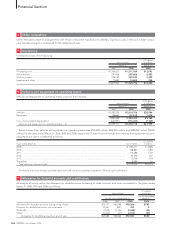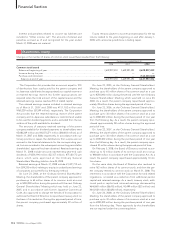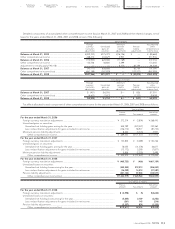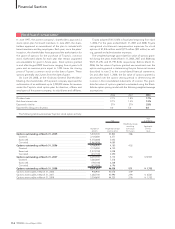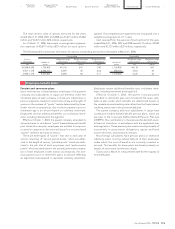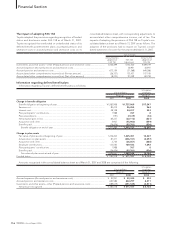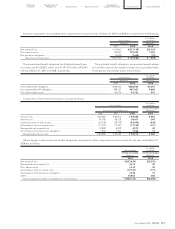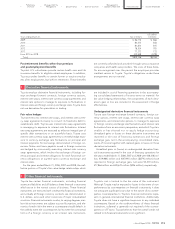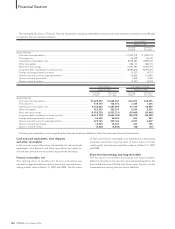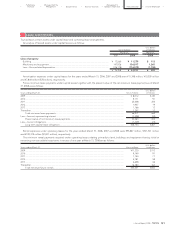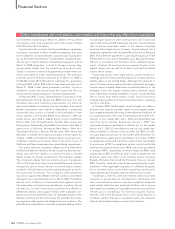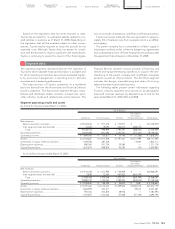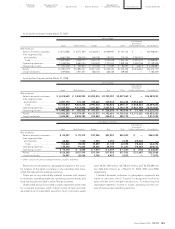Toyota 2008 Annual Report Download - page 117
Download and view the complete annual report
Please find page 117 of the 2008 Toyota annual report below. You can navigate through the pages in the report by either clicking on the pages listed below, or by using the keyword search tool below to find specific information within the annual report.
115
•Annual Report 2008 • TOYOTA
Performance Messages from the Management &
•Overview •Management •Special Feature •Business Overview •Corporate Information •Financial Section •Investor Information •
The total intrinsic value of options exercised for the years
ended March 31, 2006, 2007 and 2008 was ¥3,273 million, ¥3,866
million and ¥1,651 million ($16 million), respectively.
As of March 31, 2008, there were unrecognized compensa-
tion expenses of ¥2,677 million ($27 million) for stock options
granted. Those expenses are expected to be recognized over a
weighted-average period of 1.1 years.
Cash received from the exercise of stock options for the years
ended March 31, 2006, 2007 and 2008 was ¥4,133 million, ¥4,942
million and ¥3,333 million ($33 million), respectively.
The following table summarizes information for options outstanding and options exercisable at March 31, 2008:
Outstanding Exercisable
Exercise Weighted-average Weighted-average Weighted-average Weighted-average Weighted-average
price range Number of exercise price exercise price remaining life Number of exercise price exercise price
Yen shares Yen Dollars Years shares Yen Dollars
¥2,958–4,500 1,754,900 ¥4,118 $41 2.90 1,754,900 ¥4,118 $41
4,501–7,278 6,586,700 6,549 65 6.46 599,700 4,541 45
2,958–7,278 8,341,600 6,038 60 5.71 2,354,600 4,225 42
Pension and severance plans
Upon terminations of employment, employees of the parent
company and subsidiaries in Japan are entitled, under the
retirement plans of each company, to lump-sum indemnities or
pension payments, based on current rates of pay and lengths of
service or the number of “points” mainly determined by those.
Under normal circumstances, the minimum payment prior to
retirement age is an amount based on voluntary retirement.
Employees receive additional benefits on involuntary retire-
ment, including retirement at the age limit.
Effective October 1, 2004, the parent company amended its
retirement plan to introduce a “point” based retirement benefit
plan. Under the new plan, employees are entitled to lump-sum
or pension payments determined based on accumulated
“points” vested in each year of service.
There are three types of “points” that vest in each year of
service consisting of “service period points” which are attrib-
uted to the length of service, “job title points” which are attrib-
uted to the job title of each employee, and “performance
points” which are attributed to the annual performance evalua-
tion of each employee. Under normal circumstances, the mini-
mum payment prior to retirement age is an amount reflecting
an adjustment rate applied to represent voluntary retirement.
Employees receive additional benefits upon involuntary retire-
ment, including retirement at the age limit.
Effective October 1, 2005, the parent company partly
amended its retirement plan and introduced the quasi cash-
balance plan under which benefits are determined based on
the variable-interest crediting rate rather than the fixed-interest
crediting rate as was in the pre-amended plan.
The parent company and most subsidiaries in Japan have
contributory funded defined benefit pension plans, which are
pursuant to the Corporate Defined Benefit Pension Plan Law
(CDBPPL). The contributions to the plans are funded with sever-
al financial institutions in accordance with the applicable laws
and regulations. These pension plan assets consist principally of
investments in government obligations, equity and fixed
income securities, and insurance contracts.
Most foreign subsidiaries have pension plans or severance
indemnity plans covering substantially all of their employees
under which the cost of benefits are currently invested or
accrued. The benefits for these plans are based primarily on
lengths of service and current rates of pay.
Toyota uses a March 31 measurement date for the majority of
its benefit plans.
Employee benefit plans:
19
.



